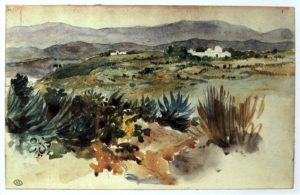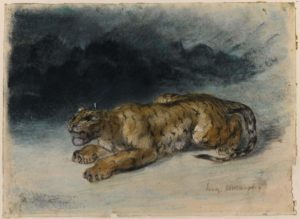Dear Artist,
No matter what our style, medium or subject matter, our work takes its cues from nature. Nature determines our accepted norms of beauty and is the basis of our ideas of design. These aesthetic semi-laws find their source in the tiniest forms — animal, vegetable and mineral. Through a universe of shells, flowers, scales, crystals, plumage, limbs, landforms, skies, to the very ends of the heavens, we read and delight in the creative hand of nature. There’s an education on the underside of any salamander.

Horse Frightened by Lightning, 1825 – 1829
Watercolour
9.29 x 12.59 inches
by Eugene Delacroix (1798 – 1863)
Science writer Philip Ball has noted, “Artists are starting to use the pattern-forming algorithms like cellular automata to create visual art and music.” Actually, nature’s structures have been actively appropriated since the dawn of human art. Design within design is the nature of nature. This raw material is a gift to creators. Here are a few non-rigid thoughts for those who might be thinking about nature in their art:

Sketchbook of Delacroix, notes from a journey to Morocco, 1832
Watercolour
8 3/16 x 11 7/16 inches
by Eugene Delacroix
Gradations attract, enfold and please.
Curves are more sensual than straights.
The obvious is enchanted by the hidden.
Protrusions are contrasted with indentions.
Patterns fascinate, involve and deceive.
Repetitions are to forms what beats are to music.
Symmetry mirrors and honours the human body.
Whorls and vortexes tempt and seduce.
Colour, pure or muted, is its own magic.
Strong contrasts provide drama and excitement.
Soft edges invite touch and caress.
Disappearing acts create mystery and intrigue.
Camouflage has both honour and mirth.
Bracts and branches are a principle of life.
Articulation rattles the bones.
Spikes and spines provide discomfort and unease.
Radiation echoes a sun god and the hand of man.
Water brings both tranquility and turbulence.
Squares and triangles give strength and stability.
The list goes on. Nature’s designs range from high schlock to understated good taste. They present us with an ever-changing march of variety and magnificence. “Nature,” says biologist Hans Meinhardt, “has been allowed to play.” Artists may take courage from this cue.
Best regards,
Robert
PS: “Nature is a dictionary; one draws words from it.” (Eugene Delacroix)
Esoterica: Witnessing natural biodiversity and the variety and adaptation of species, one might conclude that we are in a kind of Darwinian experiment where various models and designs are tested. Pure art, stripped of promotional baggage, operates in a similar way. “Appeal” is often the main criterion by which one piece stands out against the next — and determines survival. We are living at a time when design, designer, and the viewer of the design are all being tested. What about the idea of “progress”?
This letter was originally published as “Cues from nature” on February 3, 2006.
Have you considered a Premium Artist Listing? With each letter, an artist is featured at the bottom of this page. The Premium Artist Listings are a means of connecting artist subscribers through their work. Proceeds from each listing contribute to the production of The Painter’s Keys.
“Nature is inside art as its content, not outside as its model.” (Northrop Frye)
Featured Artist
My aim as a painter is to bring to life a slice of the world as I experience it. Light, color and form are my vocabulary.







7 Comments
Love this. I have always found inspiration in Nature whether it is a beautiful landscape or a small wildflower or a simple onion skin. the variety and complexity is astounding. Delacroix is a master and I appreciate seeing these landscapes which I have never seen before. Once as a young student a very gifted painter/professor, Raoul Middleman described Delacroix’s reds as “the sound of a gong”. I never forgot that idea. thank you for your ever inspiring blog.
Missing your dad today Sara. This one’s a keeper.
This is another good list to put in large print by the easel. Last night while working on a very large ( 48×60) canvas which is in the beginning stage, I again found myself most fascinated with one area that suggested things fading away and disappearing. I ask myself often “why”. Why are some small and much less important areas the ones that hold the artist’s fascination the most? I think Robert’s list here answers that.
I’m currently immersing myself in the art techniques and love of painting nature through my collection of Stephen Quiller’s books (5) and his painting demos on DVD (5). I’ve had these materials for years, yet it’s like I’m seeing them for the first time. They say that when the student is ready, the teacher appears–very true for me at this time. I’m seeing my own views to the outdoors where I live, through his eyes, and it’s a revelation. He talks about ‘alpenglow’, where a line of brilliant yellow-orange creates an edge along a ridge/mountain as the sun is setting. I was able to see this one evening through the kitchen window, and I got so excited, I almost dropped the dish I was washing. Even the list describing effects to use for improving painting is very similar to Quiller’s lists in his books. Quiller is a superb colorist and paints what he feels more than what he sees, much like Robert Genn did. In fact, they were friends and participated in pleinair workshops together. I greatly admire them both, and wonder, Sara, if you would consider talking about their friendship and post paintings by both of them? Thanks for all you do, Sara!
What a beautifully woven story! Fluffle is gentle yet impactful—its quirky charm and emotional undercurrents stayed with me long after finishing.
Fascinating reflection Slope Run — art really does mirror evolution, with creativity adapting to survive shifting tastes. Progress, perhaps, is just continual adaptation rather than a fixed goal.
I really enjoyed reading about how nature inspires artists with its endless variety and subtle details. For those who love exploring creativity in different forms, you might also want to check it out — it’s a fun online math game site that challenges your mind in a playful way!